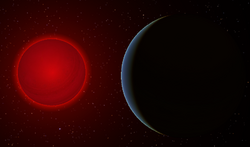Astronomy:2MASS 1237+6526
| Observation data Equinox J2000.0]] (ICRS) | |
|---|---|
| Constellation | Draco |
| Right ascension | 12h 37m 39.19632s[1] |
| Declination | +65° 26′ 14.8092″[1] |
| Apparent magnitude (V) | +16.05 |
| Characteristics | |
| Spectral type | T6.5[2] |
| Astrometry | |
| Parallax (π) | 96.07 ± 4.78[3] mas |
| Distance | 34 ± 2 ly (10.4 ± 0.5 pc) |
| Details | |
| Mass | 0.035 M☉ |
| Radius | 0.11 R☉ |
| Luminosity | 6.25x10−6 L☉ |
| Temperature | 850[4] K |
| Age | ≥2-10[4] billion years |
| Other designations | |
2MASS J12373919+6526148, 2MASSI J1237392+652615, 2MASSW J1237392+652615 | |
| Database references | |
| SIMBAD | data |
2MASS J12373919+6526148 (hereafter 2MASS 1237+6526) is a brown dwarf object with late spectral type T in the constellation of Draco, nearly 34 light-years away from the Sun.[3] The substellar object could likely host a very low-mass companion (yet undetected but inferred), possibly in the planetary regime.[2] This has been inferred from unusual Hα emission that it exhibited in the past.[5]
2MASS 1237+6526 may potentially show aurorae, which would be significant since extrasolar aurorae have not been detected, but this has not been conclusively demonstrated.[5]
Possible planetary companion
Burgasser et al. (2003)[2] have inferred the presence of a low-mass companion orbiting the brown dwarf 2MASS 1237+6526. Such object would yield a mass between 3 and 12 times that of Jupiter and take nearly 4.56 hours (0.19 days) to revolve around its dim primary. If confirmed it would be one of the shortest period exoplanets and orbiting one of the faintest hosts so far. Accounting very faint luminosity of the primary (6.25/1,000,000th of Sun's luminosity), the habitable zone is located within 0.0025 astronomical units, so the putative planet could likely retain great amounts of water and ammonia. Moreover, both the objects would appear the same size.
Template:PlanetboxOrbit begin Template:PlanetboxOrbit hypothetical
References
- ↑ 1.0 1.1 Cutri, R. M. (2003). "2MASS All-Sky Catalog of Point Sources". VizieR On-line Data Catalog. Bibcode: 2003yCat.2246....0C.
- ↑ 2.0 2.1 2.2 Burgasser (2003). "Binarity in Brown Dwarfs: T Dwarf Binaries Discovered with the Hubble Space Telescope WPFC2". The Astrophysical Journal 586 (1): 512–526. doi:10.1086/346263. Bibcode: 2003ApJ...586..512B.
- ↑ 3.0 3.1 Faherty, Jacqueline K. (2012). "The Brown Dwarf Kinematics Project (BDKP). III. Parallaxes for 70 Ultracool Dwarfs". The Astrophysical Journal 752 (1): 56. doi:10.1088/0004-637X/752/1/56. Bibcode: 2012ApJ...752...56F.
- ↑ 4.0 4.1 Liebert & Burgasser (2007). "On the Nature of the Unique Hα-emitting T Dwarf 2MASS J12373919+6526148". Astronomy & Astrophysics 655 (1): 522–527. doi:10.1086/509882. Bibcode: 2007ApJ...655..522L.
- ↑ 5.0 5.1 Saur, Joachim; Willmes, Clarissa; Fischer, Christian; Wennmacher, Alexandre; Roth, Lorenz; Youngblood, Allison; Strobel, Darrell F.; Reiners, Ansgar (2021). "Brown dwarfs as ideal candidates for detecting UV aurora outside the Solar System: Hubble Space Telescope observations of 2MASS J1237+6526". Astronomy & Astrophysics 655: A75. doi:10.1051/0004-6361/202040230. Bibcode: 2021A&A...655A..75S.
 |


